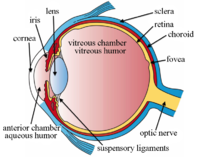
Photo from wikipedia
Abstract Background Numerous lines of evidence link periodontal pathobionts and their virulence factors with endothelial damage. Most research has been conducted using single species infections at the exclusion of other… Click to show full abstract
Abstract Background Numerous lines of evidence link periodontal pathobionts and their virulence factors with endothelial damage. Most research has been conducted using single species infections at the exclusion of other periodontal microorganisms that have been identified in vascular tissue. Here, we assessed endothelial infection with either single or mixed periodontal species infection and examined their effect on endothelial damage and permeability. Methods Cell surface abundance of platelet endothelial cell adhesion molecule‐1 (PECAM‐1) or endothelial permeability following infection with Porphyromonas gingivalis, Fusobacterium nucleatum subspecies (ssp) nucleatum, ssp polymorphum or Tannerella forsythia as single or mixed species infection was determined by flow cytometry and a fluorescent dextran permeability assay. Zebrafish embryos were infected systemically with either single or mixed species with mortality and disease measured over time. Results F. nucleatum ssp nucleatum, ssp polymorphum and P. gingivalis significantly reduced PECAM‐1 abundance in single species infection, whereas T. forsythia had no effect. F. nucleatum ssp polymorphum caused considerable mortality and morbidity in a zebrafish systemic infection model. Polymicrobial infection underscored the virulence of F. nucleatum ssp polymorphum in particular with increased endothelial cell death and reduced PECAM‐1 abundance in co‐infection studies with this organism. When injected systemically into zebrafish in polymicrobial infection, fluorescently labeled bacteria were distributed throughout the vasculature and cardiac region where, in some instances, they co‐localized with each other. Conclusions These data provide further evidence on the effects of F. nucleatum on endothelium adhesion molecule abundance and permeability while also highlighting the importance of performing polymicrobial infection to study the molecular mechanisms associated with periodontal pathogen‐induced vascular damage.
Journal Title: Journal of Periodontology
Year Published: 2022
Link to full text (if available)
Share on Social Media: Sign Up to like & get
recommendations!